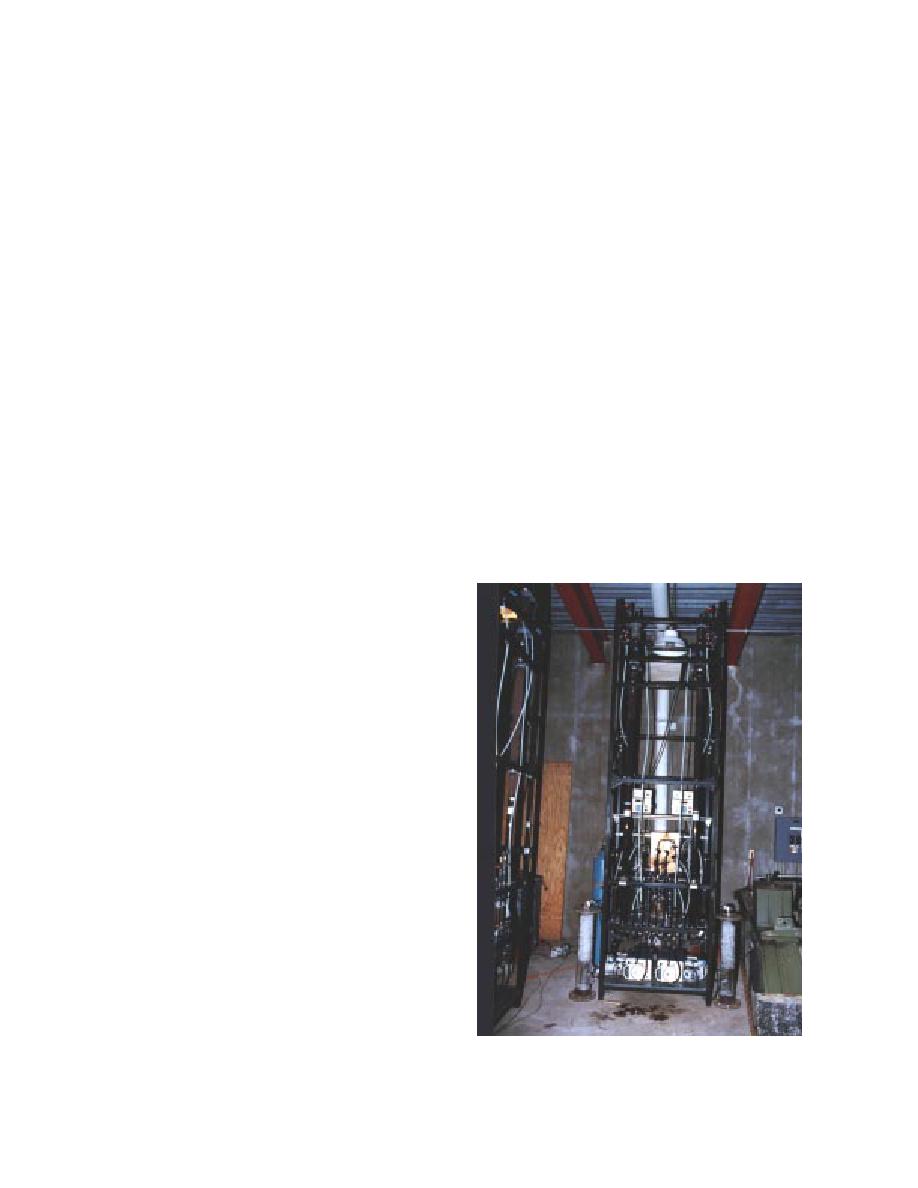
Such a system was designed at the Waterways
(1137-L) stainless steel holding tank using a bladder
Experiment Station (WES) for the treatment of
pump (Grundfus, Redi-flo2, 2-in.-diameter [5-cm-
groundwater contaminated with low levels of TCE.
diameter], submersible pump, located 20 ft [6 m]
Research into the design of this system resulted in
down the well). Groundwater could not be pumped
the use of an OPC as the sorbent and Burkholderia
directly from the well to the columns because the
cepacia (G4) as the microbe. This system was opti-
recharge rate of the well was too slow. To maintain a
mized at WES using a bench scale model unit. Once
consistent TCE concentration in the water through-
optimized, a pilot scale system was designed. Fig-
out the loading process, as well as to maintain a
ure 2 shows a schematic of the pilot scale system.
fairly constant pressure on the loading pumps, the
The objective of this work was to test and evaluate
holding tank was kept full. This was done by means
the pilot scale system and determine its feasibility as
of a siphon tube that kept the water level constant.
a cost effective alternative to current groundwater
During the loading process, the groundwater
treatment systems for TCE remediation.
was pumped from the bottom of the holding tank to
the base of each pair of columns by means of a peri-
staltic pump. The flow rate through each column
Pilot scale system and operation
The fluidized-bed adsorption bioreactor con-
was set at 120 mL/min to allow for maximum load-
sisted of a column of an adsorbent material and a
ing of the clay in the shortest time period. To ensure
bioreactor. The column was a glass tube (10 ft
that no TCE was loaded while we set the flow rate,
2-in. i.d. [3 m 2-cm i.d.]), packed with 2200 g of an
distilled water was pumped from a small carboy.
OPC material (Colloid Environmental Technologies
The groundwater was then pumped through the
Company, Clarion PM-100). The bioreactor con-
packed clay beds for 48 to 140 hours. Influent and
sisted of a 10-L glass reactor vessel fitted with a five-
effluent TCE concentrations were determined fol-
port lid, an oxygen supply, a dissolved oxygen
lowing the schedule outlined in the Sample Collec-
probe, a carbon dioxide treatment system, plus the
tion section. We defined a column to be "loaded"
draw and return lines connecting the bioreactor to
when the ratio of the effluent concentration to the
the column. The microbe used in the reactor was
Burkholderia cepacia (G4). A biotester (Liquid System
Electronic, Model LS/QA) kept the oxygen levels
between 5 and 15% of saturation. The carbon diox-
ide treatment system was a canister in which a 1-M
sodium hydroxide was circulated.
The pilot scale system was mounted on two skids
(Fig. 3), each having two adsorption columns and
the necessary plumbing for loading the columns
and providing connections to the bioreactors. The
two bioreactors were shared between these skids. A
series of peristaltic pumps (Masterflex, Inc.) were
used for loading the columns, for circulating with
water, for fluidizing the clay bed, and for removing
carbon dioxide from the reactors during remedia-
tion.
TCE-contaminated groundwater was obtained
from a site at CRREL. This is an ideal place to test
the methodology. The site is contaminated with
TCE only, so results could not be confounded by the
presence of other compounds. In addition, it is
extremely well characterized; concentrations of TCE
in the groundwater are known and are well within
the operating limits of the reactors.
The TCE-contaminated groundwater was
removed from CRREL well CECRL 11, where the
average TCE concentration was 1.52 0.18 mg/L.
Figure 3. Skid 1 of the pilot scale fluidized-bed adsorp-
To load the TCE onto the clay, groundwater was
tion bioreactor system.
pumped from the monitoring well to a 250-gallon
3



 Previous Page
Previous Page
